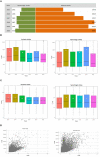The direct and indirect effects of length of hospital stay on the costs of inpatients with stroke in Ningxia, China, between 2015 and 2020: A retrospective study using quantile regression and structural equation models
- PMID: 36033765
- PMCID: PMC9415100
- DOI: 10.3389/fpubh.2022.881273
The direct and indirect effects of length of hospital stay on the costs of inpatients with stroke in Ningxia, China, between 2015 and 2020: A retrospective study using quantile regression and structural equation models
Abstract
Importance: Length of hospital stay (LOHS) is the main cost-determining factor of hospitalization for stroke patients. However, previous analyses involving LOHS did not consider confounding or indirect factors, or the effects of other factors on LOHS and inpatient costs.
Objective: To investigate the direct and indirect effects of LOHS on the hospitalization costs of inpatients with ischemic and hemorrhagic stroke.
Design setting and participants: This was a population-based, retrospective, and observational study that analyzed data acquired from the Nationwide Inpatient Sample between 2015 and 2020 relating to ischemic and hemorrhagic stroke in Ningxia, China.
Main outcomes and measures: Hospitalizations were identified by the International Classification of Diseases 10th Revision (ICD-10). Inpatient costs were described by the median M (P25, P75). We used a quantile regression model to estimate the linear relationships between a group of independent variables X and the quantile of the explained variable hospitalization cost (Y). A structural equation model (SEM) was then used to investigate the direct and indirect effects of LOHS on inpatient costs.
Results: The study included 129,444 patients with ischemic stroke and 15,525 patients with hemorrhagic stroke. The median LOHS was 10 (8-13) days for ischemic stroke and 15 (10-22) days for hemorrhagic stroke. The median M (P25, P75) of inpatient costs was $1020 (742-1545) for ischemic stroke and 2813 (1576-6191) for hemorrhagic stroke. The total effect of LOHS on inpatient costs was 0.795 in patients with ischemic stroke. The effect of yearof discharge (X4) and CCI (X8) on inpatient costs was dominated by an indirect effect through the LOHS. The indirect effect was -0.071 (84.52% of the total effect value) and 0.034 (69.39% of the total effect value), respectively. The total effect of LOHS on inpatient costs in patients with hemorrhagic stroke was 0.754. The influence of CCI on inpatient costs was dominated by an indirect effect through LOHS; the indirect effect value was -0.028 (77.78% of the total effect value). The payment type, surgery, method of discharge, and hospital level also exerted an impact on inpatient costs by direct and indirect effects through the LOHS.
Conclusions and relevance: Length of hospital stay (LOHS) was identified as the main factor influencing hospitalization costs. However, other social factors were shown to indirectly influence hospitalization costs through the LOHS. Taking effective measures to further reduce hospitalization costs remains an effective way to control hospitalization costs for stroke patients.
Keywords: costs; length of hospital stay (LOS); quantile regression; stroke; structural equation models (SEMs).
Copyright © 2022 Su, Pan, Zhao, Chen, Wang, Lu, Meng, Su and Liang.
Conflict of interest statement
The authors declare that the research was conducted in the absence of any commercial or financial relationships that could be construed as a potential conflict of interest.
Figures


Similar articles
-
How health risk factors affect inpatient costs among adults with stroke in China: the mediating role of length of stay.BMC Geriatr. 2024 Feb 5;24(1):131. doi: 10.1186/s12877-024-04656-4. BMC Geriatr. 2024. PMID: 38373895 Free PMC article.
-
Analysis of Hospital Charges of Inpatients with Acute Ischemic Stroke in Beijing, China, 2012-2015.Neuroepidemiology. 2018;50(1-2):63-73. doi: 10.1159/000484212. Epub 2018 Feb 8. Neuroepidemiology. 2018. PMID: 29421788
-
Factors influencing the hospitalization cost for stroke patients in J district, Shanghai.Zhong Nan Da Xue Xue Bao Yi Xue Ban. 2022 May 28;47(5):628-638. doi: 10.11817/j.issn.1672-7347.2022.210429. Zhong Nan Da Xue Xue Bao Yi Xue Ban. 2022. PMID: 35753733 Free PMC article. Chinese, English.
-
[Inpatient care for psoriasis: quo vadis?-A retrospective study at the University Hospitals of Aachen, Bonn, and Essen from 2010 to 2019].Dermatologie (Heidelb). 2024 Feb;75(2):170-175. doi: 10.1007/s00105-023-05234-2. Epub 2023 Oct 11. Dermatologie (Heidelb). 2024. PMID: 37819277 Review. German.
-
The In-Hospital Code Stroke: A Look Back and the Road Ahead.Neurohospitalist. 2024 Oct 29:19418744241298035. doi: 10.1177/19418744241298035. Online ahead of print. Neurohospitalist. 2024. PMID: 39544262 Free PMC article. Review.
Cited by
-
Risk factor identification and prediction models for prolonged length of stay in hospital after acute ischemic stroke using artificial neural networks.Front Neurol. 2023 Feb 9;14:1085178. doi: 10.3389/fneur.2023.1085178. eCollection 2023. Front Neurol. 2023. PMID: 36846116 Free PMC article.
-
A clinical prediction model based on interpretable machine learning algorithms for prolonged hospital stay in acute ischemic stroke patients: a real-world study.Front Endocrinol (Lausanne). 2023 Nov 22;14:1165178. doi: 10.3389/fendo.2023.1165178. eCollection 2023. Front Endocrinol (Lausanne). 2023. PMID: 38075055 Free PMC article.
-
How health risk factors affect inpatient costs among adults with stroke in China: the mediating role of length of stay.BMC Geriatr. 2024 Feb 5;24(1):131. doi: 10.1186/s12877-024-04656-4. BMC Geriatr. 2024. PMID: 38373895 Free PMC article.
-
Days Alive and Out of Hospital: Reframing Stroke Outcomes for Better Patient-Centered Care.J Am Heart Assoc. 2024 Jul 16;13(14):e035849. doi: 10.1161/JAHA.124.035849. Epub 2024 Jul 3. J Am Heart Assoc. 2024. PMID: 38958144 Free PMC article. No abstract available.
References
-
- Wang Y, Li Z, Gu H, Zhai Y, Jiang Y, Zhao X, et al. . China stroke statistics 2019: a report from the national center for healthcare quality management in neurological diseases, China national clinical research center for neurological diseases, the chinese stroke association, national center for chronic and non-communicable disease control and prevention, Chinese center for disease control and prevention and institute for global neuroscience and stroke collaborations. Stroke Vasc Neurol. (2020) 5:211–39. 10.1136/svn-2020-000457 - DOI - PMC - PubMed
Publication types
MeSH terms
LinkOut - more resources
Full Text Sources
Other Literature Sources
Medical
Research Materials

